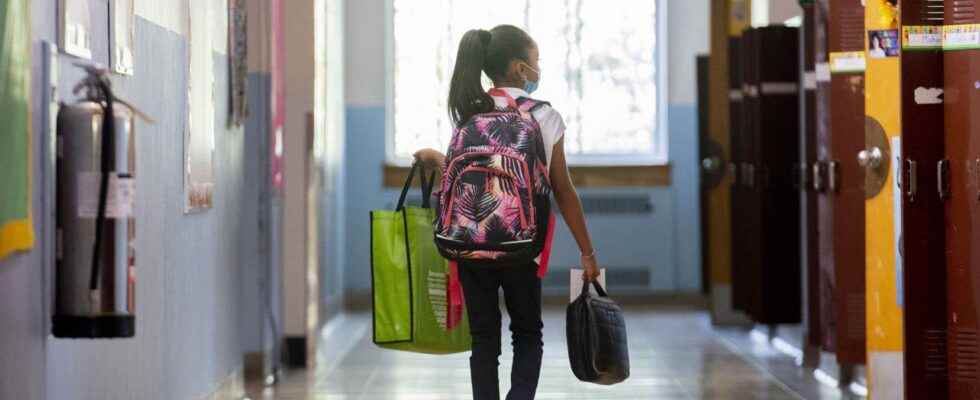This text is part of the special booklet Defining priorities on the large table of commitments
The subject was widely discussed during the recent back-to-school season. And if the problem is relatively new in some service centers, it has been known and documented for more than ten years in Montreal. In an electoral context, where education is guaranteed to be a priority, it must be admitted that for the moment, the community is being hit hard by a shortage that does not seem to be about to be reduced. .
“Returns under the sign of the shortage have worsened over the years. We know that we will start the year with classes without teachers. This is recurrent and it is a reality that has consequences for students and staff. However, it does not seem to ring a bell on the government side. We haven’t yet seen any real political will to change things or concrete actions so that we can stop the bleeding,” explains Catherine Beauvais-St-Pierre, president of the Alliance of Teachers of Montreal. (APPM).
Montreal, unattractive?
According to her, the metropolis is a victim of its failure: the problem of attraction in general education, to which is added an even greater challenge: that of retention. If people leave the teaching profession in all regions, in Montreal, they also leave for other regions.
“They continue to teach, but elsewhere. And you have to wonder why. There is a reality that is different in Montreal: allophone students, HDAA students (disabled or with adjustment or learning difficulties), underprivileged backgrounds. We have great challenges ahead. All this in a context where we teach in old schools, while more than 80% are dilapidated. » Fountains condemned because of the poor quality of the water, pieces of ceiling or walls that come off, brick that holds together with wire; it is in this context that the teachers of Montreal work, she recalls.
The staff shortage is therefore part of a vicious circle: the fewer people there are, the more difficult it is for those in place. And faced with this reality, we try as best we can to keep people. “Our bosses at the service center are looking for ways to limit the shortage, and that often involves refusing to accept part-time availability or gradual retirement, when it is accepted elsewhere,” summarizes Ms.me Beauvais-St-Pierre.
Currently, students are living with more instability in the classroom caused by staff turnover. On a daily basis, it is the most vulnerable who pay the most in this context of shortage.
Long term consequences
“Every start of the school year is Groundhog Day. It’s a panic, we are looking for non-legally qualified teachers, to the point of having at least one responsible adult per class […]. There are people in government who don’t want to face reality. It’s quite worrying. But what disturbs the most, in addition to this feeling of deja vu, is the long-term effect that is likely to be felt on a whole generation of future teachers.
Young people who are thinking of becoming teachers are entitled to a very sad picture of the profession at the moment, and that is what concerns the president. “The current situation is not conducive to attracting people. We risk having schools with fewer and fewer trained teachers. I welcome people who agree to come and lend a hand in education, but the fact is that when you do a four-year bachelor’s degree to teach, you come to class with a background and tools. »
From 2018 to today
In a February 5, 2018 union newsletter available on the Teachers’ Alliance website, the CSSDM staff shortage crisis was described as a “serious problem” and “unheard of”. This editorial, signed by Catherine Renaud, predecessor of the current president, could have been written today.
What has changed, besides a pandemic, between 2018 and the start of the 2022 school year? Few things. In the eyes of M.me Beauvais-St-Pierre, some of the gains from the most recent collective agreement are a step in the right direction, but she doubts the current government realizes the extent of the problem.
See education differently
Valuing the profession and respecting professional autonomy are possible solutions, according to her. “It takes more than a good employment contract, it takes a political vision that is different from the one we currently have. But for now, there is no light at the end of the tunnel. »
Among the solutions, she also talks about giving ourselves the means so that the public school lives up to what students, teachers and staff should be entitled to as an educational and working environment.
From a national point of view, we will seek this year to obtain gains that will be orchestrated around the conditions of exercise of teachers. But more specifically for the APPM, where the problem of retention and attraction is even greater, Catherine Beauvais-St-Pierre hopes that we will bring benefits to which other service centers are entitled, such as pensions progressive or part-time mandates.
“We must also recognize the Montreal school for its different needs. To achieve this, the government must demonstrate its desire not only to make the profession attractive, but also to make it attractive to Montreal. Otherwise, the shortage could be reduced elsewhere in Quebec, but not at the CSSDM. »
